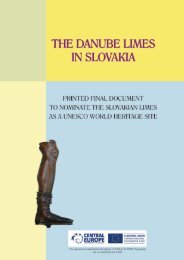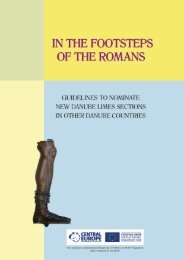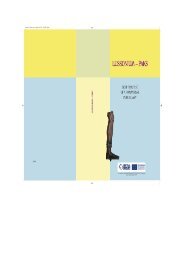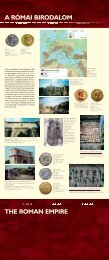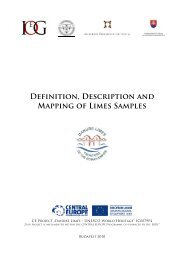the PDF version! - Danube Limes
the PDF version! - Danube Limes
the PDF version! - Danube Limes
You also want an ePaper? Increase the reach of your titles
YUMPU automatically turns print PDFs into web optimized ePapers that Google loves.
Frontiers of <strong>the</strong> Roman Empire – Ripa Pannonica in Hungary (RPH) Nomination statement<br />
5. Protection and Management of <strong>the</strong> Property<br />
5.a Ownership/stakeholders<br />
The 121 individual sites show a mixed distribution in terms of ownership, and within this every site is<br />
comprised of several lots.<br />
The 121 nominated individual sites contain a total of 162 archaeological sites.<br />
Total number of lots nominated: 4645<br />
Number of lots in <strong>the</strong> nominated property: 2773<br />
Number of lots in <strong>the</strong> buffer zone: 1871<br />
Ownership distribution:<br />
State ownership: 5.7% 265 lots<br />
Local government ownership: 20.0% 929 lots<br />
Private ownership<br />
(individual and joint –<br />
total of 2147 owners): 74.3% 3451 lots<br />
100% 4645 lots<br />
In Hungary <strong>the</strong>re are essentially two types of ownership: public ownership and private ownership. The<br />
two main types of public ownership are recognized, state ownership and local government ownership. In<br />
both cases <strong>the</strong> rights of <strong>the</strong> abstract community (<strong>the</strong> state or <strong>the</strong> local government) are held by a lots<br />
manager, which can be a legal entity or even a private individual designated by <strong>the</strong> organ of state or<br />
local government with jurisdiction over this. There can also be two kinds of private ownership, joint<br />
or individual ownership. Joint owners can be any kind of economic company, association, corporation<br />
with legal status, registered church, civic organization, foundation or co-operative, etc. The experience in<br />
Hungary following <strong>the</strong> change – in 1990 – of <strong>the</strong> “socialist” state system that restricted private ownership<br />
is that <strong>the</strong> state’s share of <strong>the</strong> national wealth, which was <strong>the</strong>n ca. 90%, has dropped significantly in favor<br />
of local government and private ownership. Even today this process cannot be considered to have been<br />
concluded. There are legal opportunities for <strong>the</strong> privatization of state and local government lots. In many<br />
cases a single lot may have several forms of ownership mixed toge<strong>the</strong>r, and <strong>the</strong> ownership structure is<br />
constantly liable to change.<br />
In Hungary <strong>the</strong> owners of lots must be entered in <strong>the</strong> land registry records, and changes are continuously<br />
recorded. In addition to this, <strong>the</strong> deed of ownership records <strong>the</strong> size of <strong>the</strong> lot and its character – i.e.<br />
an agricultural area or one that is excluded from cultivation. It is also obligatory to indicate <strong>the</strong> type of<br />
agricultural land use, and any change to this is only possible on <strong>the</strong> basis of an official permit. The proposed<br />
World Heritage site encompasses several thousand lots. To provide a comprehensive and illustrative picture<br />
of <strong>the</strong>ir ownership status is impossible. The diverse mosaic of ownership conditions is however regulated<br />
by <strong>the</strong> Law LXIV of 2001 on cultural heritage, which stipulates <strong>the</strong> obligation to maintain <strong>the</strong> character<br />
of cultural heritage, and that this maintenance is required to be performed by <strong>the</strong> existing owner.<br />
71



